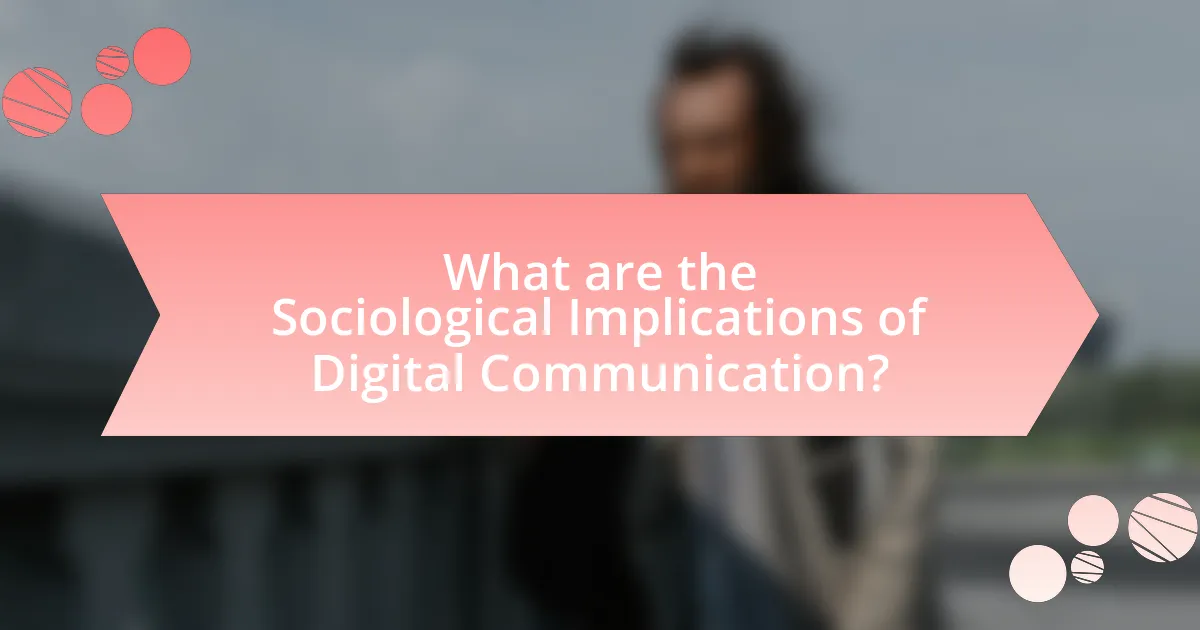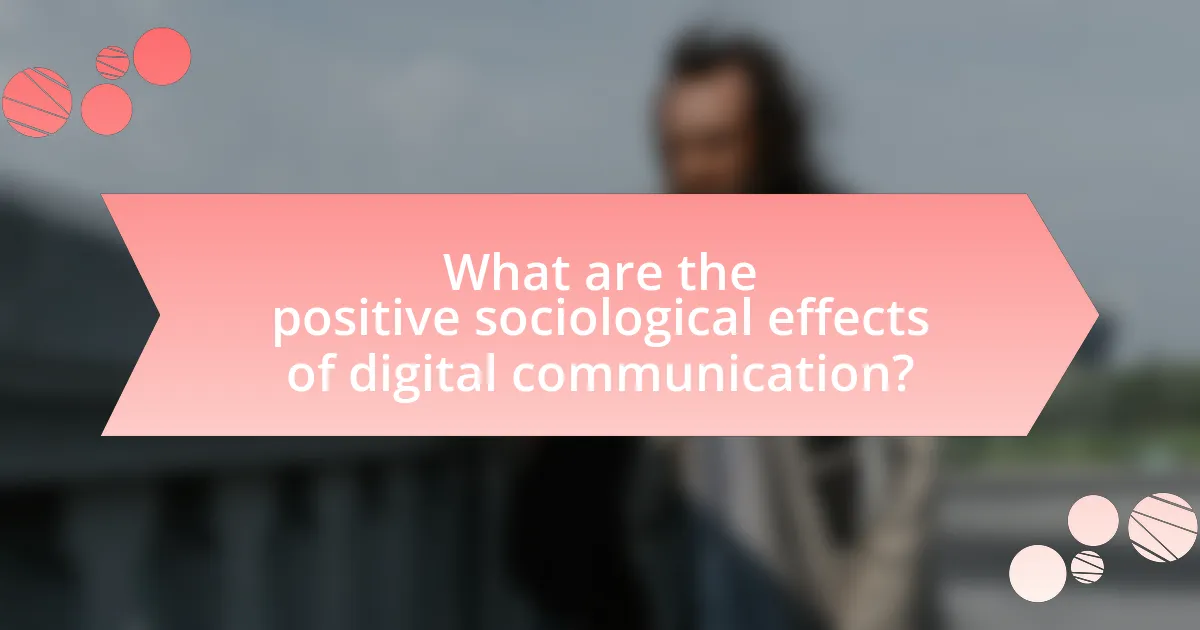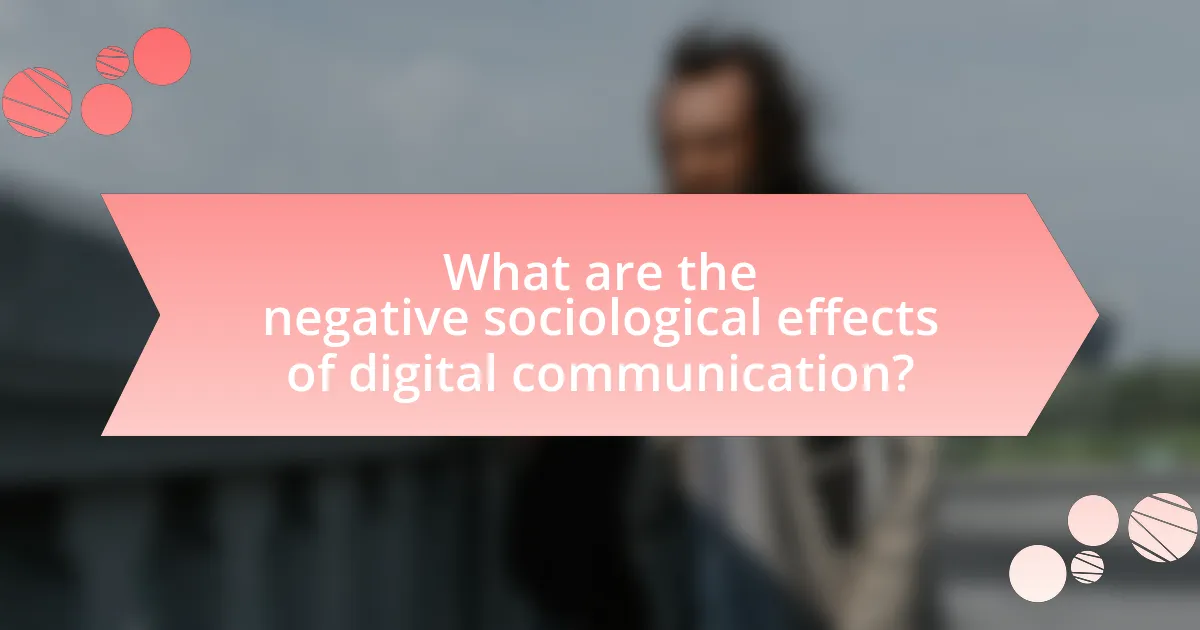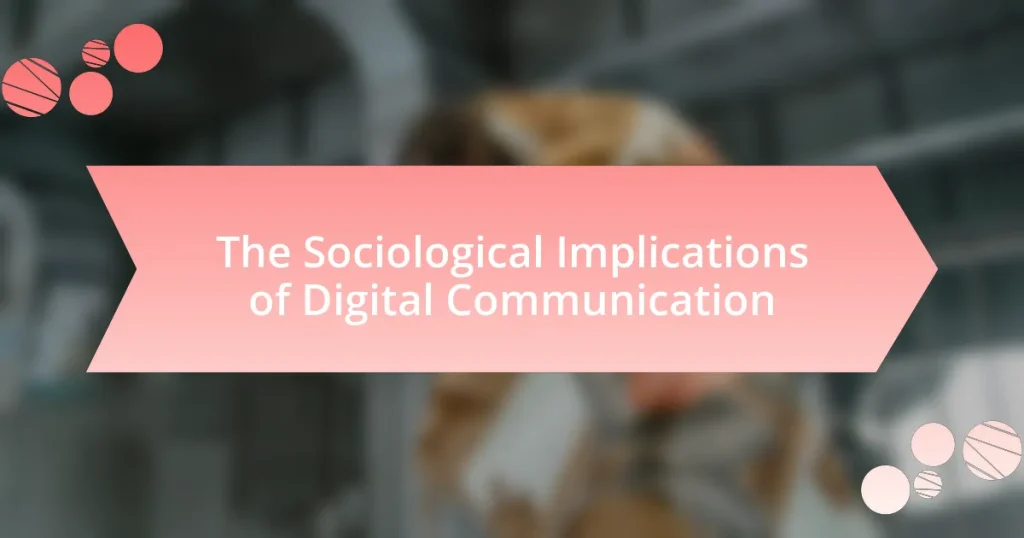The article examines the sociological implications of digital communication, highlighting its transformative effects on social interactions, relationships, and identity formation. It discusses how digital platforms foster global connectivity while also contributing to social isolation and the creation of echo chambers that reinforce existing beliefs. Key changes in communication patterns, the impact on interpersonal relationships, and the role of digital communication in shaping cultural norms and social movements are analyzed. Additionally, the article addresses both the positive and negative effects of digital communication, including the promotion of inclusivity and the risks of misinformation, ultimately emphasizing the importance of understanding these dynamics in contemporary society.

What are the Sociological Implications of Digital Communication?
Digital communication significantly alters social interactions, impacting relationships, community structures, and identity formation. It fosters global connectivity, allowing individuals to maintain relationships across distances, yet it can also lead to social isolation as face-to-face interactions decline. Research indicates that digital communication can create echo chambers, where individuals are exposed primarily to viewpoints that reinforce their own beliefs, potentially increasing polarization (Sunstein, 2001). Additionally, the anonymity provided by digital platforms can lead to disinhibition, resulting in both positive and negative behaviors, such as increased self-expression or cyberbullying. Overall, the sociological implications of digital communication are profound, influencing how individuals relate to one another and shaping societal norms.
How has digital communication transformed social interactions?
Digital communication has transformed social interactions by enabling instant connectivity and facilitating the formation of online communities. This shift has altered how individuals communicate, allowing for real-time exchanges regardless of geographical barriers. For instance, platforms like social media have created spaces where people can share experiences and ideas, leading to the emergence of global networks. Research indicates that 4.9 billion people were active internet users in 2021, highlighting the widespread adoption of digital communication tools. This transformation has also influenced social norms, as interactions increasingly occur through text, video, and images rather than face-to-face conversations, reshaping interpersonal relationships and community dynamics.
What are the key changes in communication patterns due to digital platforms?
Key changes in communication patterns due to digital platforms include increased speed, accessibility, and the shift from face-to-face interactions to virtual communication. Digital platforms enable instantaneous messaging and information sharing, allowing users to communicate across vast distances in real-time. Research indicates that over 4.9 billion people globally use social media, which has transformed traditional communication methods into more text-based and visual formats, such as emojis and memes. Additionally, the rise of asynchronous communication allows individuals to engage at their convenience, altering the dynamics of conversation and response times. These changes reflect a significant shift in how relationships are formed and maintained, emphasizing the importance of digital literacy in navigating modern communication landscapes.
How do these changes affect interpersonal relationships?
Changes in digital communication significantly affect interpersonal relationships by altering the way individuals interact and connect. Increased reliance on digital platforms can lead to superficial connections, as face-to-face interactions are often replaced by text-based communication, which lacks emotional depth. Research indicates that 70% of communication is non-verbal, highlighting the importance of physical presence in building strong relationships. Furthermore, studies show that excessive use of social media can lead to feelings of isolation and decreased satisfaction in personal relationships, as individuals may prioritize online interactions over meaningful in-person connections. These shifts can result in weakened social bonds and a decline in the quality of interpersonal relationships.
Why is understanding digital communication important for society?
Understanding digital communication is crucial for society because it shapes how individuals interact, share information, and form communities. The rise of digital platforms has transformed traditional communication methods, enabling instant connectivity and access to vast information networks. For instance, according to a Pew Research Center study, 90% of adults in the U.S. use the internet, highlighting the pervasive role of digital communication in daily life. This understanding fosters critical skills such as digital literacy, which is essential for navigating misinformation and engaging in informed discourse. Furthermore, recognizing the implications of digital communication can enhance social cohesion and promote civic engagement, as evidenced by the role of social media in mobilizing movements like Black Lives Matter.
What role does digital communication play in shaping cultural norms?
Digital communication significantly influences the formation and evolution of cultural norms by facilitating the rapid exchange of ideas and values across diverse populations. This technology enables individuals to share experiences and perspectives, which can lead to the adoption of new social behaviors and attitudes. For instance, social media platforms have been shown to amplify movements such as #MeToo and Black Lives Matter, reshaping societal views on gender and racial equality. Research indicates that 72% of adults in the U.S. use social media, highlighting its role as a primary medium for cultural discourse. Consequently, digital communication acts as a catalyst for cultural change, allowing for the dissemination and reinforcement of emerging norms on a global scale.
How does digital communication influence social identity and group dynamics?
Digital communication significantly influences social identity and group dynamics by facilitating the formation and reinforcement of online communities. These platforms allow individuals to express their identities and connect with like-minded peers, which can enhance feelings of belonging and solidarity within groups. Research indicates that social media usage can lead to the development of distinct group norms and values, as users curate their online personas to align with group expectations. For instance, a study by the Pew Research Center found that 69% of adults in the U.S. use social media, which often shapes their social interactions and identity perceptions. This interconnectedness can also lead to group polarization, where individuals adopt more extreme views as they engage with others who share similar beliefs, thereby impacting group dynamics and social cohesion.

What are the positive sociological effects of digital communication?
Digital communication fosters social connectivity, enabling individuals to maintain relationships across geographical boundaries. This connectivity enhances social support networks, which are crucial for mental well-being. Research indicates that online interactions can lead to increased feelings of belonging and community, particularly among marginalized groups. For instance, a study published in the Journal of Computer-Mediated Communication found that individuals who engage in online communities report higher levels of social capital and emotional support. Additionally, digital communication facilitates the exchange of diverse perspectives, promoting cultural understanding and tolerance. This exchange can lead to greater social cohesion and collective action, as evidenced by the role of social media in mobilizing movements like Black Lives Matter.
How does digital communication enhance social connectivity?
Digital communication enhances social connectivity by facilitating instant and widespread interaction among individuals across geographical boundaries. This immediacy allows people to maintain relationships, share experiences, and collaborate in real-time, which strengthens social ties. For instance, a study by Pew Research Center in 2021 found that 97% of Americans use the internet, with social media platforms enabling users to connect with friends and family, thereby fostering a sense of community and belonging. Additionally, digital communication tools like messaging apps and video calls have become essential for maintaining relationships, especially during events like the COVID-19 pandemic, where physical interactions were limited. This shift illustrates how digital communication not only bridges distances but also enhances the quality and frequency of social interactions.
What are the benefits of online communities and networks?
Online communities and networks provide numerous benefits, including enhanced social interaction, access to diverse perspectives, and opportunities for collaboration. These platforms facilitate connections among individuals regardless of geographical barriers, fostering a sense of belonging and support. Research indicates that participation in online communities can lead to increased social capital, as users build relationships and networks that can be beneficial in various aspects of life, such as career advancement and emotional support. Additionally, studies show that online networks can enhance knowledge sharing and innovation, as members contribute unique insights and skills, leading to collective problem-solving and creativity.
How does digital communication facilitate social movements and activism?
Digital communication facilitates social movements and activism by enabling rapid information dissemination and fostering community engagement. Platforms like social media allow activists to share messages, mobilize supporters, and organize events efficiently, reaching a global audience almost instantaneously. For instance, the Arab Spring in 2010-2011 showcased how Twitter and Facebook were instrumental in coordinating protests and sharing real-time updates, leading to significant political changes in several countries. Additionally, studies indicate that online campaigns can increase participation rates; for example, the Ice Bucket Challenge raised over $115 million for ALS research in just a few months, demonstrating the power of digital communication in rallying support for causes.
In what ways does digital communication promote inclusivity?
Digital communication promotes inclusivity by providing accessible platforms for diverse voices and facilitating real-time interaction across geographical barriers. These platforms, such as social media and messaging apps, enable individuals from various backgrounds, including those with disabilities, to participate in discussions and share their perspectives. For instance, features like text-to-speech and closed captioning enhance accessibility for individuals with hearing or visual impairments. Additionally, digital communication allows marginalized groups to organize and mobilize effectively, as seen in movements like Black Lives Matter, which gained momentum through online platforms. This democratization of communication fosters a sense of belonging and community among users, reinforcing the idea that everyone can contribute to societal dialogues.
How does it provide a platform for marginalized voices?
Digital communication provides a platform for marginalized voices by enabling direct access to audiences without traditional gatekeeping barriers. This democratization of information allows individuals from underrepresented communities to share their experiences, perspectives, and narratives through social media, blogs, and other online forums. For instance, platforms like Twitter and Instagram have been instrumental in movements such as #BlackLivesMatter and #MeToo, where marginalized groups have mobilized support and raised awareness about social injustices. Research indicates that social media can amplify these voices, as evidenced by a Pew Research Center study showing that 69% of adults in the U.S. believe social media is an effective tool for marginalized communities to express their views.
What are the implications for diversity in communication styles?
Diversity in communication styles significantly impacts interpersonal interactions and organizational dynamics. Different cultural backgrounds influence how individuals express themselves, interpret messages, and respond to others, leading to potential misunderstandings or conflicts. For instance, research indicates that high-context cultures, which rely on implicit communication, may struggle to connect with low-context cultures that favor explicit verbal exchanges. This divergence can hinder collaboration and create barriers in digital communication platforms, where nuances may be lost. Furthermore, organizations that embrace diverse communication styles can enhance creativity and problem-solving by integrating varied perspectives, as evidenced by studies showing that diverse teams outperform homogeneous ones in innovation.

What are the negative sociological effects of digital communication?
Digital communication has several negative sociological effects, including decreased face-to-face interactions, increased social isolation, and the spread of misinformation. The reliance on digital platforms often leads individuals to prefer online communication over in-person interactions, which can weaken social bonds and reduce the quality of relationships. Research indicates that heavy use of social media correlates with feelings of loneliness and depression, as users may feel disconnected from their immediate social environments. Additionally, the rapid dissemination of misinformation through digital channels can create societal divisions and erode trust in institutions, as seen during events like the COVID-19 pandemic, where false information spread widely, impacting public health responses.
How does digital communication contribute to social isolation?
Digital communication contributes to social isolation by reducing face-to-face interactions, which are essential for building meaningful relationships. Studies indicate that increased reliance on digital platforms can lead to feelings of loneliness and disconnection, as individuals may substitute online interactions for in-person connections. For instance, research published in the American Journal of Preventive Medicine found that individuals who frequently use social media report higher levels of perceived social isolation compared to those who engage in more direct social interactions. This shift towards digital communication can create a paradox where individuals feel more connected online but experience greater isolation in their real lives.
What are the psychological impacts of reduced face-to-face interactions?
Reduced face-to-face interactions lead to increased feelings of loneliness and social isolation. Research indicates that individuals who engage less in direct social interactions experience heightened anxiety and depression levels. A study published in the American Journal of Preventive Medicine found that social isolation can increase the risk of mental health issues, with a significant correlation between reduced social contact and depressive symptoms. Furthermore, the lack of non-verbal cues in digital communication can hinder emotional understanding, exacerbating feelings of disconnect. This evidence underscores the psychological toll that diminished in-person interactions can have on individuals.
How does online communication affect the quality of relationships?
Online communication can both enhance and diminish the quality of relationships. It enhances relationships by facilitating constant connectivity, allowing individuals to maintain contact regardless of geographical barriers, which can strengthen emotional bonds. For instance, a study published in the Journal of Computer-Mediated Communication found that individuals who engage in frequent online communication report higher levels of relationship satisfaction. Conversely, online communication can diminish relationship quality due to the potential for miscommunication and reduced face-to-face interactions, which are crucial for building trust and understanding. Research from the Pew Research Center indicates that excessive reliance on digital communication can lead to feelings of isolation and decreased intimacy among individuals. Thus, the impact of online communication on relationships is multifaceted, with both positive and negative effects depending on usage patterns.
What are the risks of misinformation and digital echo chambers?
Misinformation and digital echo chambers pose significant risks to societal cohesion and informed decision-making. Misinformation can lead to the spread of false beliefs, influencing public opinion and behavior, as evidenced by studies showing that false news spreads six times faster than true news on social media platforms. Digital echo chambers reinforce existing beliefs by limiting exposure to diverse viewpoints, which can result in polarization and increased hostility among different groups. Research from the Pew Research Center indicates that individuals in echo chambers are less likely to engage with opposing perspectives, further entrenching divisive ideologies. These dynamics can undermine democratic processes and public trust in institutions, as seen during events like elections where misinformation can sway voter behavior.
How does misinformation spread through digital platforms?
Misinformation spreads through digital platforms primarily via social media algorithms that prioritize engagement over accuracy. These algorithms amplify sensational content, leading to rapid dissemination among users. A study by Vosoughi, Roy, and Aral in 2018 found that false news stories are 70% more likely to be retweeted than true stories, highlighting the role of user interaction in spreading misinformation. Additionally, the ease of sharing content and the lack of stringent fact-checking mechanisms on many platforms contribute to the proliferation of false information.
What are the consequences of echo chambers on public discourse?
Echo chambers significantly polarize public discourse by reinforcing existing beliefs and limiting exposure to diverse perspectives. This phenomenon leads to increased social division, as individuals become more entrenched in their viewpoints and less willing to engage with opposing ideas. Research indicates that echo chambers contribute to the spread of misinformation, as users are more likely to share content that aligns with their beliefs without critically evaluating its accuracy. A study by the Pew Research Center found that 62% of social media users encounter news that reflects their views, further entrenching their opinions and diminishing constructive dialogue. Consequently, echo chambers undermine democratic processes by reducing the quality of public debate and fostering an environment where consensus becomes increasingly difficult to achieve.
How can individuals navigate the challenges of digital communication?
Individuals can navigate the challenges of digital communication by developing clear communication strategies and enhancing their digital literacy. Clear strategies include setting specific goals for communication, choosing appropriate platforms for different messages, and being mindful of tone and context to avoid misunderstandings. Enhancing digital literacy involves understanding the tools and technologies used in communication, which can improve the effectiveness of interactions. Research indicates that effective digital communication skills can lead to better collaboration and reduced conflict in online environments, as highlighted in studies by the Pew Research Center, which found that 70% of individuals believe that digital communication can lead to misunderstandings if not handled properly.
What strategies can enhance healthy digital interactions?
To enhance healthy digital interactions, individuals should prioritize clear communication, establish boundaries, and practice empathy. Clear communication reduces misunderstandings and fosters positive exchanges, as evidenced by studies showing that clarity in messaging leads to better relationship satisfaction. Establishing boundaries, such as limiting screen time and defining acceptable online behavior, helps maintain a healthy balance between digital and real-life interactions. Practicing empathy, which involves understanding and sharing the feelings of others, can significantly improve online relationships; research indicates that empathetic communication reduces conflict and enhances social connections in digital environments.
How can one critically evaluate information encountered online?
To critically evaluate information encountered online, one should assess the credibility of the source, verify the accuracy of the content, and consider the context in which the information is presented. Evaluating the credibility involves checking the author’s qualifications, the publication’s reputation, and the presence of citations or references. Verifying accuracy requires cross-referencing facts with reliable sources, such as academic journals or official reports. Contextual consideration includes understanding the purpose of the information, potential biases, and the intended audience. Research indicates that individuals who apply these criteria are more likely to discern misinformation effectively, as demonstrated in studies by the Stanford History Education Group, which found that students often struggle to evaluate online sources critically.
